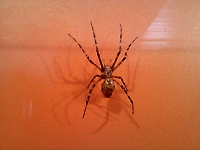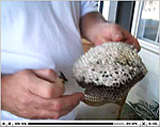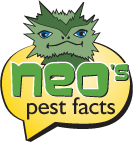Generally, orb-weaving spiders are three-clawed builders of flat
webs with sticky spiral capture
silk. The building of a web is an engineering feat, begun when the spider floats a line on the wind to another surface. The spider secures the line and then drops another line from the center, making a "Y". The rest of the scaffolding follows with many radii of non-sticky silk being constructed before a final spiral of sticky capture silk. The third claw is used to walk on the non-sticky part of the web. Characteristically, the prey
insect that blunders into the sticky lines is stunned by a quick bite and then wrapped in silk. If the prey is a
venomous insect, such as a wasp, wrapping may precede biting.
Many orb-weavers build a new web each day. Generally, towards evening, the spider will consume the old web, rest for approximately an hour, then spin a new web in the same general location. Thus, the webs of orb-weavers are generally free of the accumulation of detritus common to other species such as black widow spiders.
Most arachnid webs are vertical and the spiders usually hang with their head downward. A few webs, such as those of orb-weaver in the genus Metepiera have the orb hidden within a tangled space of web. Some Metepiera are semi-social and live in communal webs. In Mexico such communal webs have been cut out of trees or bushes and used for living fly paper. [citation needed]. Information furnished here from Wikipedia.
The reduction of spiders and their webs can be done through good housekeeping by
removal of their webs after dusk. Changing exterior lighting from white to yellow bulbs can
cut down on their food source because flying insects (a spiders food source) are attracted to
the light. A professional pest control program can help elminate a spiders food source. Provided by UPM.







